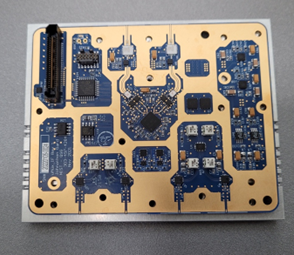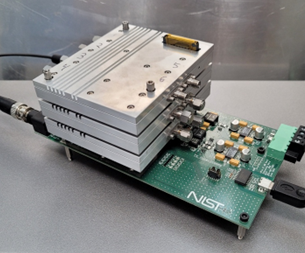Summary
The Sensor Readout Project within the Quantum Electronics Group leverages the sensitivity of superconducting quantum interference devices (SQUIDs), low-noise superconducting parametric amplifiers, and other novel superconducting devices to enable low-noise and large-scale readout of sensitive cryogenic sensors.
Description
NIST’s Quantum Sensors Division develops highly sensitive cryogenic sensors, for example transition-edge sensors (TESs) and kinetic inductance detectors (KIDs), to enable precision measurements in a large range of scientific applications. The successful implementation of these novel sensor technologies requires low-noise readout techniques that can scale to size of the required sensor arrays, while simultaneously satisfying the thermal requirements of the cryogenic systems that cool the sensors. The Sensor Readout Project designs low-noise amplifiers and multiplexing circuits that are optimized for sensors produced both within the Quantum Sensors Division and the larger community using low-temperature detectors. To enable the widest adoption of these technologies, the Sensor Readout Project also designs and builds the custom room-temperature electronics necessary to perform end-to-end readout with these systems.
Major Accomplishments
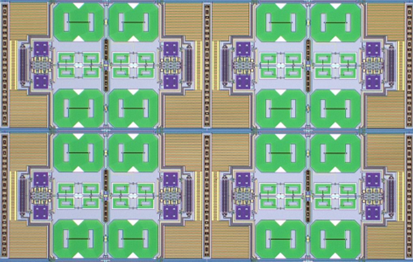
Development of SQUID ammeters for the next generation of X-ray observatories
X rays are emitted by astrophysical objects that have been heated to millions or tens of millions of degrees. By studying these highly energetic objects, which include accretion disks around black holes, remnants of supernova explosions, and the “cosmic web” of plasma that surrounds and contains galaxy clusters, x-ray astronomers hope to answer their deepest questions, like “how does structure form in the Universe?” X-ray astronomy must be performed from space because the earth’s atmosphere prevents cosmic x rays from reaching the ground.
A new generation of x-ray observatories, led by the European Space Agency’s (ESA’s) Athena mission and its X-IFU instrument, will apply the Quantum Sensors Group’s (QSG’s) Superconducting Quantum Interference Device (SQUID) ammeters to x-ray astronomy. The X-ray Integral Field Unit (X-IFU) is an imaging x-ray spectrometer, which is essentially a color camera for x rays. The camera will contain a pixelated array of several thousand transition-edge sensors (TESs), which NASA will deliver to ESA. The TES array will provide very accurate and precise knowledge of the energies (colors) of the x rays which can, for example, be used to determine the speed of their emitting object via the Doppler shift of known x-ray lines. NASA has contracted NIST’s QSG to provide the readout circuitry for the signal currents from the TESs.
The Athena satellite is intended to launch in the mid-2030s. More information about Athena X-IFU can be found here. Additional astronomy observatories that may use NIST QSG’s SQUID-readout circuitry are being proposed. However, the SQUIDs made by the QSG have already been to space aboard the High-Resolution Microcalorimeter X-ray Imaging Rocket (Micro-X).
Micro-X is a project funded by NASA that consists of transition-edge sensor array as the camera for a x-ray space telescope that is flown on sub-orbital sounding rockets within the NASA sounding rocket program. Both the SQUID multiplexed readout and the onboard readout electronics were made by the QSG.
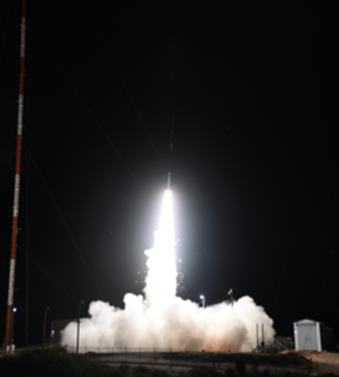
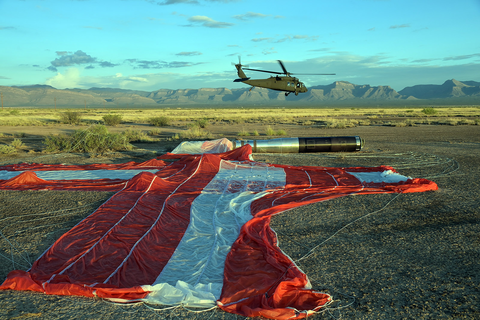
Development of Microwave SQUID multiplexing
The scale of instruments based on microcalorimeter arrays and bolometer arrays has increased significantly over the last decade. To meet the demand to readout these large cryogenic sensors arrays, the Quantum Sensors Readout project is developing new multiplexing technology based on superconducting microwave resonators coupled with rf SQUIDs (Superconducting QUantum Interference Devices). This multiplexing technique, known as microwave SQUUD multiplexing, takes advantage of the significant bandwidth available at microwave frequencies to readout on order of a thousand sensors simultaneously on a single pair of coaxial cables.
Quantum Sensors Readout project works with the other projects with the Quantum Sensors Group to fabricate and deploy the microwave SQUID multiplexers. Microwave SQUID multiplexers are currently used within our group for nanoscale X-Ray tomography of integrated circuits [Szypryt et. al., arXiv:2212.12073 (2022)], and are deployed to Los Alamos National Laboratory and Idaho National Laboratory in gamma-spectrometers based on transition-edge sensor microcalorimeters [Croce et al. (2022)], the University of Milano-Biocco in experiments to detect the neutrino mass [Alpert et al. (2015)], and to the Simons Observatory for imaging of the Cosmic Microwave Background [The Simons Observatory: Astro2020 Decadal Project White Paper], among others. The Quantum readout project is also currently working on maturing this technology for a potential future NASA x-ray satellite mission [Lynx X-ray Observatory].
Room temperature multiplexing readout components
To promote the wider adoption of the sensor and multiplexing technology developed in the Quantum Sensors Group, the Quantum Sensors Readout project also designs and builds the custom room-temperature electronics necessary to perform end-to-end readout with these systems. For example, we have developed intermediate frequency conversion electronics that convert the signals between microwave SQUID multiplexers in the range of 4-8 GHz and the high-speed analog-to-digital conversion cards running at a giga sample per second that are used to demultiplex these signals. We have also developed the custom firmware and software to enable multiplexed readout with these high-speed analog-to-digital conversion cards [Gard et al. (2018)]. Most of the microwave SQUID multiplexed readout systems in operation worldwide use firmware and software developed by the Quantum Sensors group.
